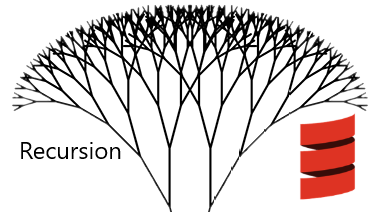Tail Recursion: Why and How-to Use in Scala
Read my blog post to know more about the advantages of tail recursion, and how do you use it in Scala.

In the below code, I have written a recursive function that multiplies all the natural numbers up to the number passed as a parameter to the function. As you might have guessed, this is nothing but computing the factorial of a particular number.
def recursiveProd(x: Int): BigInt = {
if (x <= 1)
return 1
else
return x * recursiveProd(x-1)
}Let us see how this function is being executed as a whole assuming we executed recursiveProd(5):
recursiveProd(5)
5 * recursiveProd(4)
(4 * recursiveProd(3))
(3 * recursiveProd(2))
(2 * recursiveProd(1))
1
120From above, each recursive call has to be completed first before the actual work of calculating the product begins. Each recursive call saves the current state, and proceeds to call the next recursive function. This happens repeatedly until the base case is reached. In between, you might also encounter the Stack Overflow error.
So, in each step you execute 2 steps, retrieve the current value and the value from the next stage (as a recursive call), and then multiply them. Subsequent recursive calls will do the same. If you can visualize this correctly, you will notice this recursive call was completed in 14 computations (4 multiplications, 5 recursive calls, 5 returning values), with computations happening in each step.
Tail Recursion
Now let’s consider Tail Recursion. In Tail Recursion, all the processing related to the recursive function must finish before the recursive call takes place. This means that if a function is tail-recursive, the last action is a call to itself.
def tailRecursiveProd(x: Int, currentTotal: BigInt): BigInt = {
if (x <= 1)
return currentTotal
else
return tailRecursiveProd(x - 1, currentTotal * x)
}In this scenario, despite there being a multiplication operation, it happens when the argument is passed to the next recursive call. In short, we send the current state of the recursive call to the next state, and the same process will be repeated until the base case is reached. Let us see how this is executed:
recursiveProd(5,1)
recursiveProd(4,5)
recursiveProd(3,20)
recursiveProd(2,60)
recursiveProd(1,120)
120In this way, we can save up additional stack memory which would've otherwise be wasted to compute the multiplications at every return step. Thus, this implementation only takes 10 computations (5 recursive calls, 5 returning values). This is equivalent of you using a loop to process the factorial.
Thus, you should always try and convert your recursive function into a tail recursive function wherever possible.
Tail Recursion in Scala
One good thing about Scala is that it automatically recognizes two types of tail-recursive methods automatically and optimizes them. These types are:
- Methods within an
object - Methods defined as
final
Sadly, if you write a non-final tail-recursive function inside a class, or even a case class, it will not be automatically optimized by the Scala Compiler because a class can be extended and these methods can be overriden. Consider my code given below:
object Bm {
def nTailRecursion(n: Int): Int = {
if (n == 0) 1 else nTailRecursion(n - 1)
}
}
case class Bm() {
def tailRecursion(n: Int): Int = {
if (n == 0) 1 else tailRecursion(n - 1)
}
final def tailsRecursion(n: Int): Int = {
if (n == 0) 1 else tailsRecursion(n - 1)
}
}You can see that all these functions are doing the same task. Now:
- Start a Scala REPL (Install Scala on your machine, then type
scalaon your command line/terminal and press Enter) - Type
:pasteand press Enter - Paste the code snippet above
- Press
Ctrl-Dto exit the paste mode
Then, try running Bm.nTailRecursion(60000) and Bm().tailsRecursion(60000). I've tried that on my current laptop with an Intel i7-8750H processor and 16GB RAM, and both of them worked fine. Now, when you try running Bm().tailRecursion(60000), you see a familiar java.lang.StackOverflowError which usually occurs with recursive function:

Sure, you could play around with the JVM memory limits and possibly execute this function properly. You must always remember that memory is an intensive resource, and non-availability of memory might crash other programs, as well as your current program.
Fortunately, Scala provides the @tailrec annotation to denote that a method is actually tail-recursive. First you will have to import scala.annotation.tailrec and place that annotation before the function you want to mark as tail-recursive. Place this annotation before tailRecursion() inside the case class and now copy-paste inside the REPL and try again. This time it won't throw the dreaded java.lang.StackOverflowError
Convert a recursive function to a tail-recursive function
In some cases, you might want to retain the original method's signature (eg. Factorial). This can be done using the following steps:
1. Create a second function
Within the recursiveProd as defined in the first code piece above, we now define another method, cumulativeRecursion with two parameters: n, our number and res, the result of recursion. We retain the algorithm of the first method as is. At this point our new method looks like:
def recursiveProd(n: Int): Int = {
def cumulativeRecursion(n: Int, res: Int): Int = {
if (n <= 1) 1
else n * recursiveProd(n - 1)
}
}2. Modify the second method's algorithm
We will now utilize the accumulator we've just created, res and modify the function such that the base case returns the accumulated value and the other case recursively calls the new method again:
def recursiveProd(n: Int): Int = {
def cumulativeRecursion(n: Int, res: Int): Int = {
if (n <= 1) res
else cumulativeRecursion(n - 1, res * n)
}
}3. Annotate the second method and call the new method
We will now annotate our new method with @tailrec as shown earlier and we will now call this method from our original method:
def recursiveProd(n: Int): Int = {
@tailrec def cumulativeRecursion(n: Int, res: Int): Int = {
if (n <= 1) res
else cumulativeRecursion(n - 1, res * n)
}
cumulativeRecursion(n, 1)
}Hence, you retain your method's original signature, as well as converted it into a tail-recursive call (Though this will add 1 extra stack call to the new function).
CONCLUSION
In this post, I have:
- Defined Tail Recursion
- Introduced
@tailrecannotation - Shown a formula to convert a recursive function into a tail-recursive one.
Hope you have enjoyed this post. Do follow my profiles on LinkedIn, GitHub and Twitter.
Ciao, until the next post.
Reference: Tail Recursive Algorithms

